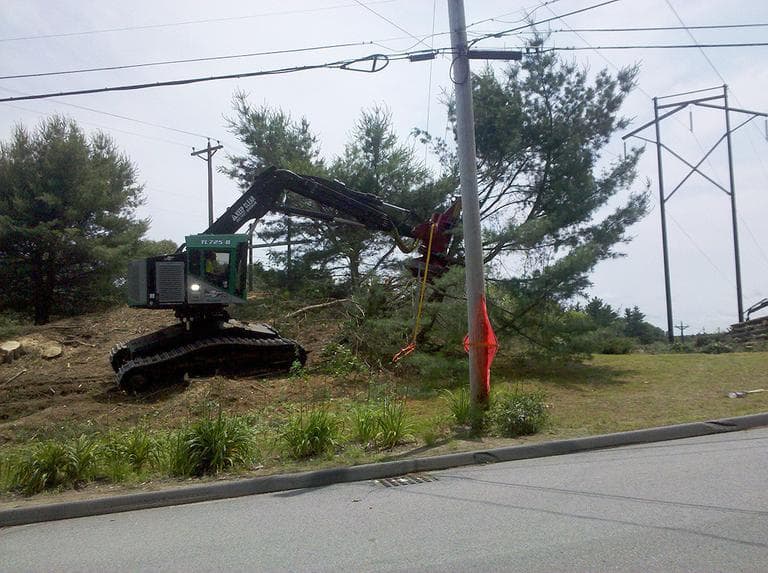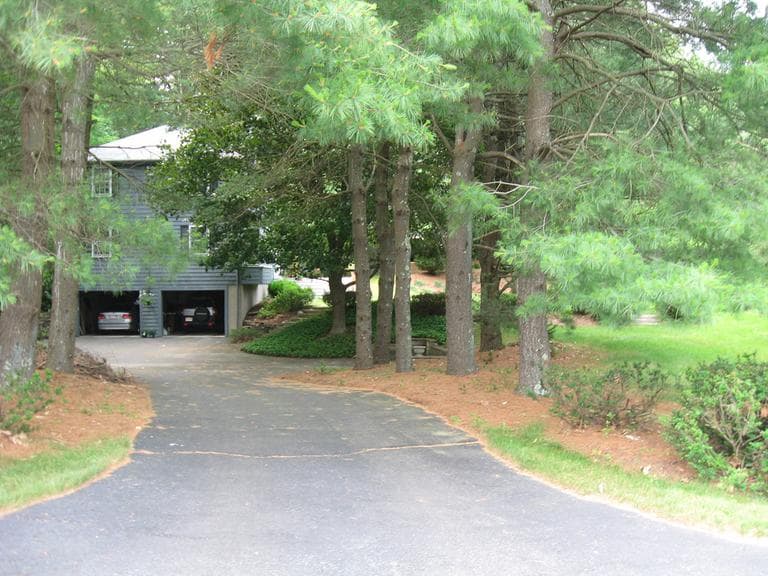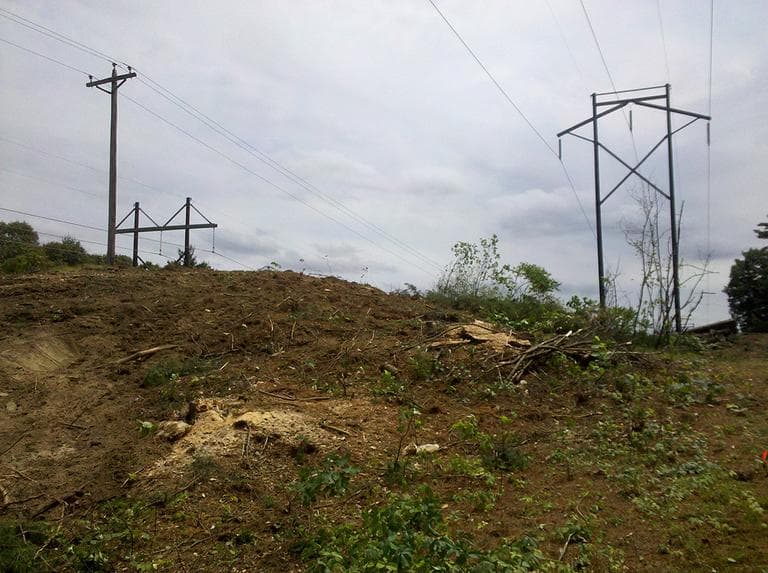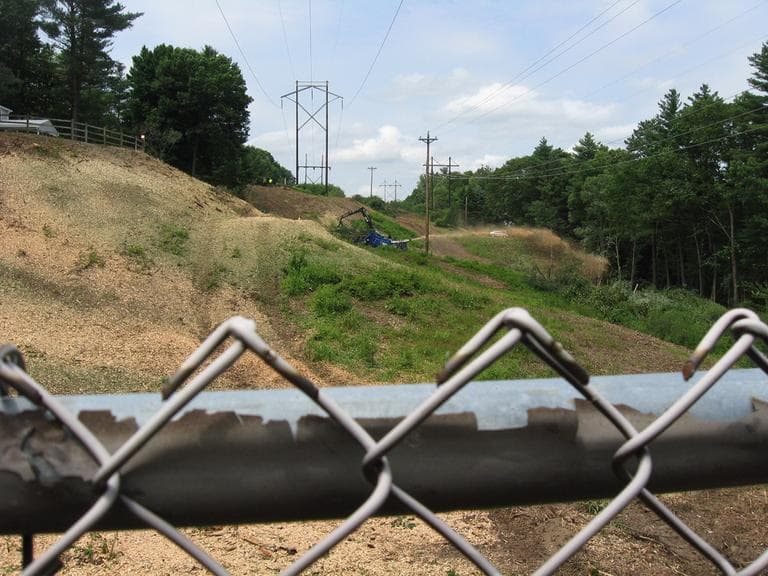Advertisement
Residents Protest NStar's 'Scorched Earth' Tree Clearing
Resume
If you were one of the 2.5 million people who lost power during last October's surprise snowstorm, you may remember that falling trees were the primary cause of those outages. Utility companies took a lot of heat then, and after past storms, for not having done enough tree maintenance. But they say the work they're doing now should help prevent future damage.
Some of that work involves a giant machine that looks like an excavator, except that at the end of its mechanical arm is a massive spinning blade and huge claw that can take down a tree in seconds. Crews working for NStar were using that machine this week to remove trees near its high-voltage power lines along Oak Hill Road in Wayland. A horrified Meg McConnell, who lives nearby, looked on as even trees bordering driveways were targeted for removal.
"I wept. I wept this morning leaving my house," McConnell said. "God, this looks awful!"
It's part of what NStar calls a "vegetation management program," now happening in Wayland, Framingham, Natick, Sudbury and part of Sherborn. The utility started this program two years ago to protect its high-voltage lines and finished work in several northern communities last year. But now these MetroWest residents are up in arms over what they say is a sudden and drastic change in the utility's approach to tree maintenance.

"Is this overkill? I think so," said state Rep. Tom Conroy, who represents the area and has been trying to get NStar to take a step back. The utility used to keep a buffer zone of trees but is now clearing a much wider swath: its entire 250-foot right-of-way under all its high-voltage lines. Some land bordering the lines has been stripped almost bare — a "scorched earth" policy, one resident called it. And many homeowners say the company is using equipment so fast and powerful that groves of trees fell before they had time to ask questions or try to stop it.
"Are they being overzealous in terms of taking their legal rights and the easement they have dating back from 1950 to its nth degree? Yes, I think they're going too far," Conroy said.
During a discussion about the tree clearing at a packed Sudbury Board of Selectmen meeting this week, resident Kris Lutz came to the microphone holding enlarged color photos that he'd mounted on poster board.
"What I've done is I've brought some pictures and I'll pass them around to the group," Lutz said. "This is my side yard, and my kids think a tornado came by. They came home off the bus and thought that this had happened one day to them."
Lutz said NStar showed up on his property last week with a piece of equipment he called "the Brontosaurus machine" — that's actually its name, by the way, the "Brontosaurus" — and ripped out his kids' sandbox, newly planted roses, a cable line and several sprinkler heads.

"I mean, this is how close and real it is to my house — that my irrigation system, my children's playground, my flower beds were just savaged. And it really truly brought my property value down significantly," he said.
Four NStar reps attended the Sudbury meeting, where one of the selectmen called them "a monopoly acting like a monopoly."
NStar arborist Bill Hayes did most of the talking.
"There's a lot of trees that have been there for decades now," Hayes said. "Residents have enjoyed them for those decades. And they've come to a point now where we have to remove them at this point."
Hayes said NStar's understanding of the best way to maintain vegetation near power lines has evolved over time. He also said NStar doesn't just take into account whether a tree has the potential to hit a line.
"It's also a matter of access into the areas in order to get line trucks in," he explained. "These line trucks are not the typical buckets you see out on street-side. These are 100-foot-plus booms and they require a fair footprint in order to do their work."
Almost every speaker at the Sudbury meeting said they understand the importance of protecting the power system. But they noted that the tree-clearing happening now isn't being done near the low-voltage distribution lines that run up and down town streets. Instead, it's targeting the high-voltage transmission lines that Selectman Bob Harrde pointed out account for a minuscule amount of storm damage.

"Instead of addressing the cause of those outages, you're cutting down trees that didn't impact those outages," Harrde said to the NStar employees. "So you can probably start to understand our frustration at what you're doing here in Sudbury."
But NStar argues that even one tree-damaged high-voltage line can affect tens of thousands of customers, so it must keep them clear.
After the meeting, I spoke with NStar project manager Brian McDevitt and asked him if the company had, at a minimum, botched the public relations aspect of this job.
"The property owners weren't going to be happy with this work that had to be done in any way, shape or form no matter how it was communicated," McDevitt said. "We tried to approach it in the right way. We have someone fully dedicated to meeting with the property owners to explain the extent of the work. The challenging piece is it's not something that a property owner wants to hear."
Back in Wayland, resident Robert Noa is waiting to hear how a judge will rule on a lawsuit he filed against NStar that's led the utility to delay clearing his property. He said he believes NStar has decided that no trees is the best vegetation management policy of all.
"I think there is a 'neighbors-be-damned, let's look at the dollars-and-cents aspect of what we're doing here,'" Noa said. "They can come in, they can clear-cut, and they can effectively forget about us for the next three decades."
In the meantime, NStar said it will meet individually with property owners to talk about planting replacement trees and landscaping.
This program aired on June 14, 2012.